
If you've paid attention to insect photography over the past decade, you'll likely have noticed that a single lens, Canon's MP-E 1-5x macro, has come to dominate the market. Every professional insect photographer I know owns one, and many of the dedicated amateurs do as well. Indeed, some photographers have even switched from Nikon to Canon just to be able to use it.
Yet the lens is also a throwback, possessing few of the electronic features of modern camera technology. It is largely manual, with no auto-focus or image stabilization, and is notoriously difficult to operate. So what's the deal? Why has a cantankerous retro lens become the glass of choice for macro?

MP-E 65mm f2.8 1-5x macro lens mounted on an EOS 20D camera body, in many respects the ideal back for this specialized lens.
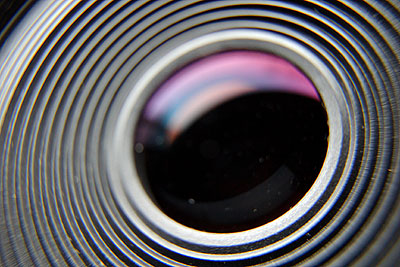
The business end of the MP-E.
To answer this question, it is helpful to understand that most macro lenses are essentially standard camera lenses with a movable element inside that allows them to focus close to the camera in addition to their standard reach out to infinity. They can shoot a distant mountain and effortlessly zing back to capture the flower at your feet.
These lenses have plenty of flexibility, but at a cost of low magnification. Standard macros do not go past 1:1, a ratio that indicates the size of the projected image on the sensor to the size of the subject. That is, a 1:1 lens takes a centimeter long bug and projects it as a centimeter long image on the sensor. That is not really magnification per se, which is unfortunate from an entomological perspective. The vast majority of insect species are less than a few millimeters long, much too small for most macro lenses.
The MP-E is an entirely different beast. It functions only as a macro (no mountain vistas for this glass!) starting at 1:1 and going to 5:1. It is a microscope strapped to a camera, capturing the hairs on the leg of a beetle or the crystalline edges of snowflakes.  Below is an example of the MP-E's range on an APS-C size sensor (that in the Canon's EOS rebel and 10/20/30/40/50D cameras):
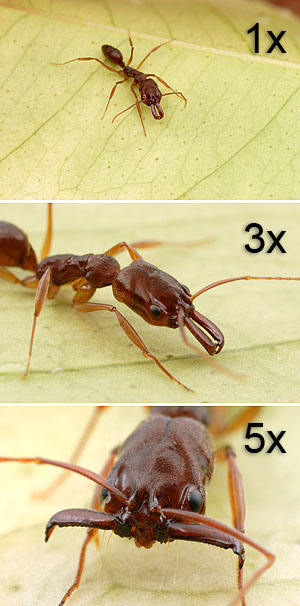
Before the MP-E, photographers achieved magnification beyond 1:1 through creative stacking of lenses, bellows, or extension tubes. Extreme macro was possible but required more effort and planning. The MP-E is an all-in-one system. Optically it performs like an old-fashioned bellows, except the cumbersome bellows have been swapped out for a convenient twist-ring. The success of the MP-E stems in part from an ability to reproduce the power of the earlier Rube Goldberg macro contraptions in a much simpler unit.

When the ring is rotated the tube extends, pushing the lens away from the camera. The farther the glass moves from the camera's sensor, the closer the focus distance approaches the front of the lens. At full extension the front lens element focuses a mere couple centimeters ahead, and the effect of a small lens sitting practically on top of the subject is extreme magnification. The subject is projected at five times its size on the camera's sensor. A 4mm ant nearly fills the 22mm APS-C frame.
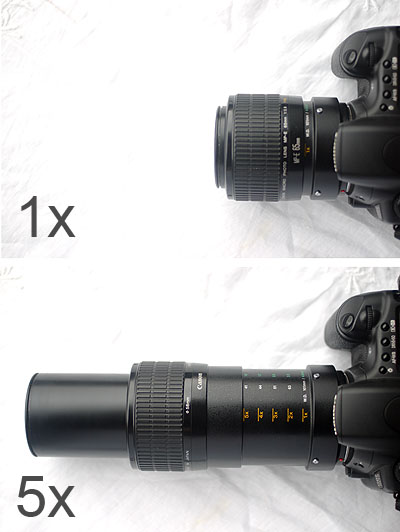
The MP-E lens looks and behaves differently at the opposing extremes of its range.
Simple as it may be, the MP-E is not for the faint of heart. For one, focusing is not what you'd expect. As the focal distance is fixed by the magnification level, focus is achieved not by turning a ring on the lens but by moving the whole camera back and forth. Pretty ghetto for an $850 lens. At higher magnifications, the focal plane is so tight that slight tremors of the hand swing the subject wildly in and out of focus.

Furthermore, the lens is little more than a long dark tube with a small opening. The effective aperture at 5x and f/16 is an astoundingly small f/96. The result approaches that of a pinhole camera: little light reaches the viewfinder or the sensor.
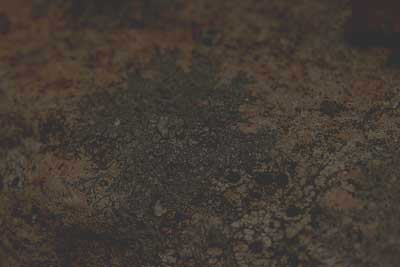
The greatest difficulty with using this lens is orientation. Not only is the viewfinder dark, but at high magnification the macroscape becomes an alien world devoid of recognizable landmarks. Typically I'll put a beetle on a rock, plainly visible to the naked eye, and spend the next 5 minutes hunting fruitlessly through the murky viewfinder trying to locate the thing, careening blindly about in the dark with objects swinging in and out of focus. The first time with the lens can be disconcerting. I spent months developing a proper sense of how to aim and steady it. I've also started using a flashlight to illuminate the subject.
Forget about using the MP-E without a flash. In ambient light you'd have to mount it on a tripod (the lens does ship with a rail mount) and shoot motionless subjects under long exposures to get enough photons to the sensor for a workable exposure. Canon sells two excellent flash units, the MR-14EX ring flash and the MT-24EX twin flash, both designed to work with the MP-E lens, and aficionados of the lens often rig other lighting solutions using various brackets, speedlites, and diffusers.
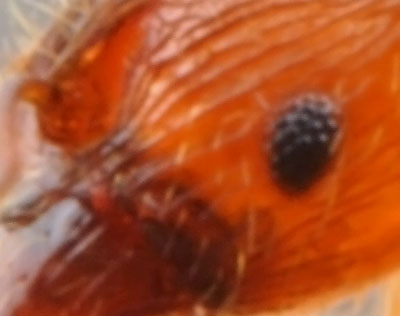
The small aperture has the advantage of extending depth of field, but the trade-off is image softness. By 2-3x, the image is fuzzy enough that even an older 6 megapixel sensor starts to out-resolve the lens. For this reason you won't gain much by pairing the MP-E with the newest 15+ megapixel cameras. If all you shoot is extreme macro, you can save a pile of money buying older camera backs with lower resolution. The image quality won't suffer.
Another problem with the small effective aperture is sensor dust. Every little hint of a speck on the sensor becomes visible and is brought into sharp detail by 5x. Users of the MP-E spend most of their free time cloning dust constellations out of their photos.
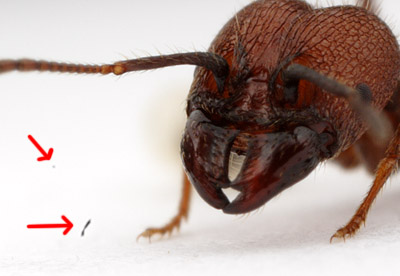
With all the trouble of a quirky lens that takes weeks of practice to use, why bother?
Well, the image quality is superb. No other lens on the market can compete with it beyond 1:1. I've assembled some sample shots below:
The sturdy build of the MP-E is also excellent, equal in quality to Canon's pricey professional "L" lenses. It is a solid, meaty lens that weathers abuse well. The front element is difficult to damage as it sits retracted behind the rim.
The MP-E is a specialist's lens. It produces astounding results, but only for those with the patience to practice it like a musical instrument. If you shoot a lot of macro, you either own it already or probably should. For those who dabble in macro or are just starting out in photography, the MP-E's steep learning curve may not justify the price.
Links:

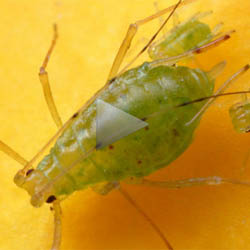
Wow..wow and more wow...what great shots!
I wont begin to understand all about those lenses..but interesting stuff...
Great review! You did a much better job of showing the difficulties of this lens than I did.
I agree that diffraction becomes an issue as you get into higher magnifications and apertures, but I think it depends more on the pixel pitch of the camera than the megapixels.
I currently use a 5D Mark II with my MP-E 65 and have found that I can get sharp pictures at 2x-3x and f/11. Past that I do have to size the shot down.
Keep in mind that even though the 5D Mark II is a 21 Megapixel camera, it has the same pixel pitch as the 20D. However, the problem is certainly much worse on the 50D.
Another nice thing about the Mark II is the dust removal. I have been using mine for some time without cleaning the sensor once and I do see a few small dust spots but nothing like what I used to see with the original 5D.
Well said! And great photos (of course :-))
calevphoto- Really? As soon as I read your review I realized that I'd not done as good a job as you had explaining that this thing doesn't focus to infinity (or even focus at all). It's such a quirky piece of glass.
Do you find that the lens is easier to use through the big, bright viewfinder of the 5D? That might persuade me to follow the 5D line of cameras. Otherwise, my next camera will be the 50D, if only for the sensor-cleaning capabilities.
I nodded my head to every sentence. I have a love/hate relationship with the lens, but it can't be beat. I tend to use only 1-3x magnification due to the problems you mentioned. Plus, I find it near impossible to get a moving insect into the view finder, let alone focus (manually) on it if I do. If I'm lucky, the creature will take a break long enough to snap off a few shots at 4x or higher.
And I'm still removing dusk from photos I took over a month ago! Despite all these frustrations, it is my favorite lens to use.
PS - I couldn't get your slideshow to work. It just loaded a black screen on my PC (Firefox 3.0.5)
Thanks Alex, you cleared all the questions I had about this lens!
One question relating to body-lens pairing though. Given an APS-C size camera sensor, I suppose you can say that this lens is already working as a short telephoto macro lens in terms of base magnification. For insect photography, is this an advantage? And, supposing the current trend in the industry leads all digital SLR towards the larger 35mm size equivalent sensor, is this a bad or a good thing for macrophotography? Does it matters?
Kolby: try this link instead. It leads to the gallery that supports the slide show.
Roberto: as calevphoto pointed out earlier, what really matters as far as magnification is concerned is the density of pixels on the sensor. As long as the current trend towards full-frame sensors is accomplished by adding additional pixels to the edges rather than spacing out the existing ones (that is, keeping the density high), then the trend is a welcome one. Fortunately, this seems to be the case. It'll allow us to keep shooting very small insects- though perhaps cropping out the empty space at the margins- while adding the ability to shoot somewhat larger animals. If I shot a lot of scarab beetles with the MP-E, I'd already own a full-frame camera.
As it is, I shoot mostly ants, so I've not seen any reason to buy the more expensive full-frame cameras. That'd just mean extra cropping work in photoshop.
Because of the small apertures common in macro-photography, this form of shooting is not very demanding of sensors. The technology for good digital macro arrived in full several years ago, and the subsequent improvements have been relatively minor ones with diminishing returns.
Macro instead is highly demanding of optics and and strobes, so I suspect future advances will take place in those areas. I'd really like to see a mass-produced wide-angle macro- something like a 15mm wide that goes beyond 1:1. And Canon really should follow Nikon's lead and make their twin flash wireless.
Hi,
This was a great article, very interesting and informative, along with some excellent images. I just had one question. How do you keep the insects still enough to focus on them? Do you use dead specimens, or just have a large store of patience?
Thanks!
Parker: Yeah, that's the really hard part. I blogged about that problem here:
http://myrmecos.wordpress.com/2008/03/30/photo-technique-working-with-a…
The Mark II supposedly has a better viewfinder than the original 5D. I honestly haven't seen a big difference here, though I think there is an improvement over a 40D I used once.
The 40D/50D have an advantage in that due to the crop factor it seems like you get more magnification and you get more DOF. However, with the 5D Mark II the advantage is much smaller. Yes, you can technically get more magnification on the 50D but the lens won't be able to resolve it as you found. In terms of DOF, it's all in the framing.
Of course, one huge advantage with the Mark II is that you can take videos with the MP-E 65. I haven't done that yet (need to find the right subject + figure out how to keep the camera still) but I have made use of the video feature for other purposes.
Given a choice between the 50D and the 5D, I would go with the 50D simply due to the dust removal. However, I would take a 5D Mark II over a 50D any day.
I do have a 100% crop of a spider taken at 5x f/11 with the 5D Mark II at http://calevphoto.com/2009/01/09/the-mystery-of-the-six-legged-spider/
The photo isn't very good and there is diffraction but I don't think it is too bad considering I probably could have gotten the focus better.
This was a great post. I had considered getting the MP-E when I was looking at macro lenses, but ultimately the final decision was based on the pocketbook, not the capabilities of the lens. I met in the middle with the Canon 100mm macro, a 1:1 lens that was very highly reviewed. Although it couldn't get as close as I really rather wanted to, it was a few hundred dollars cheaper. I discovered that the Canon 500D Close-up Lens (which I already had) fit on the 100mm macro, and I've been using that combination for all of my macro shots (such as the Citronella ants). It's worked well for me, but I still envy the sorts of photos you post to your blog! If and when I do eventually manage to get the MP-E, it's good to have a sense of the lens' quirks going in.
Nice review. I read this before I rented the MP and am rereading now for any tips. I knew focusing would be a challenge. But I also thought, "how hard could it REALLY be?" Wow, it's a PAIN, but when I get it to work, its really nice. I'm taking 2-4x of peoples eyes. I missed the thing about f/4 I was playing around with aperture because everything was coming out soft, so I figured, stop down for more sharpness, but I'll try f/4 on Tuesday when I shoot again. I also ordered (rent) the focusing rail that I thought I was too cool for. Even being able to position/guide peoples heads with my hands, it's no precise enough... Any other tips you have to tame this beast- please shoot me an email!
Thanks!
I am vascillating between the 100mm f/2.8 and the mp-e. I have done Macro for years off and on. I don't do bugs but I love to get inside flowers, stamens etc. Which would be a better lens for canon 40D?
@mollie edwards
Unless you are shooting for scientific stock or another similar purpose- I think this will be WAY too close for you, or at least, everything past 2.5x will go to waste. After my experience, I realized that it's an incredible lens, but aside from my project, insect/scientific photography and shooting hyper macro for the cool factor, I can't really see much use for it.
Ask yourself, what x factor do you REALLY need?
I would highly suggest renting it first to get a feel too. This lens is NOT like any other lens I've ever used. And do yourself a favor and DON'T SKIP the focusing rail, YOU WILL NEED IT.
I got both the lens and rail from LensRentals.com, they had excellent customer service and got the lenses to me fast.
Hi, great shots!
I have a Canon 1000D and Canon 60mm f/2.8 macro lens.
My question is, why do the dust marks start showing up when you use the lens at smaller apertures? The smaller the aperture, the more the marks show.
Is it simply because you are taking a photo with less light through the aperture? I have tried different illumination and shutter speeds, but they don't seem to affect the dust marks. Also the dust marks don't show up when I use another lens with similar shutter speeds and illumination.
Can you explain why the dust should show up only when you use a macro lens at small aperture? It really puzzles me. I haven't tried cleaning the sensor, I am a little too scared to do that myself!
Sorry to bother, I did some more googling and found this:
http://www.openphotographyforums.com/forums/archive/index.php/t-511.html
It has some good theories :)
Gostaria de informações sobre todas as novidades das lenstes canon.
This lense is really good for the money spent. It produces great images for being a very inexpensive lense. I still am a little nervous about the make of it, especially since it's made out of plastic. I just handle it with a little extra care than my other lenses. Hopefully I can get alot of wear out of it. Either way, I already got my moneys worth.
I've heard that an adapter ring is available to use the Canon macro lens on a Nikon D300 body. Is that the case, and is there any further information on how to order?
Thank you very much for this review, it has very helpful information. I've purchased the lens not too long ago and have been experimenting trying to shoot bugs, and so far I have only been able to get somewhat decent shots of slow ones (caterpillars and so on).
I have the Twin lite flash, do you think that plus sunlight are enough for handheld shots? Should I use an external flash too?
Wow... I would really buy this lens if I am a Canon user and Macro lover.
Nikon, what is your response?
The result is very nice, i will try it.
Amazing!!! Eager to try it!
In my specialization this lens would be very very helpful!
Future is coming with astrological adaptation
Hi, this is a great review! I currently have a new 450D XSI digital rebel and have been looking for a good macro lens to take pictures of most Hymenoptera. Do you know if anyone has attempted to use this body with this lens? Also if you do would you think its worth getting the lens based on the quality it can get?
Is there no other easier to use macro lense that offer anthing better than 1:1?
The difficulty is not so much with the lens itself but with the conditions of high magnification. Any optics that take you beyond 1:1 are going to be rather tricky to aim and with an extremely narrow depth of field. Wide-angle lenses will help in this regard, but you'll need to use extension tubes to be able to focus closely.
I found this blog late, but i absolutely love seeing what other people are doing with this lens, and you explained its 'ways' so well.
I hope you don't mind me sharing my favorite picture i caught with mine: http://www.flickr.com/photos/tfangel/4059891717/
Nice pics. The lens is difficult to use as you mentioned. I prefer my Tamron 180mm Macro on a Canon 40D with a Canon 580EX II flash. I can shoot at f32 with the flash for best DOF, completely auto exposure and auto focus with the Tamron, makes for fast shooting. I gets me to 1:1 but with a good SLR, Photoshop, and a couple of other tools I can get close to 1:5 and still shoot at f32, ISO 100 or 200.
The newer SLR's with higher pixel counts will allow one to crop even further with great results.
Love your ant pics, will have to give that a try.
See http://hiheels.com/img/Mantid_Head_C.jpg
for a pic that proves the statement on your second pic on this blog incorrect, this is almost full frame shot with the equipment listed above.
The Tamron 180mm has a removable tripod ring that I used to make a bracket for the Canon 580EX II flash.
See http://hiheels.com/img/40D_Macro.jpg for details.
Bracket can be turned around if needed.
The Canon 580EX II flash head zooms, guide number(feet)
is 190 at the 105mm zoom setting, LOTS of light.
We all have our different ways at getting what we want, keep up the good work!!
Awesome photos!
This is a fantastic camera! Easy to work and takes beautiful pictures. Great Camera Great Price!
Hey there,
I'm a big fan of this lense - or the pictures it takes, I should say, since I never used it.
Beeing notoriously short on cash lead me to an alternative for the student purse - a retroadapter/lense reverse ring. Costs around 15 bucks, and will give a magnification of around 4x with the canon kit lense 18-55mm.
Handling is a bit difficult though - you have to lock the apperture to a certain value when taking off the lense, and need a rather high value to get acceptable depth of field.
If anyone is looking for some comparative picture material, have a look at this german site: http://www.traumflieger.de/desktop/retroadapter/retroadapter.php. Not propagating the attached shop though, other sources offer better prices.
Note that (to my knowledge) only canon lenses can keep the apperture locked after removal from the camera body, which is essential.
Its a very cheap way of sniffing into high-magnification photography for the motivated hobbyist, even although handling isnt always easy. An extra light source will help focussing through the closed apperture. The DOF is always a bit of an issue, but for non-moving objects its great to combine with picture stacking software (as Alex introduced at a different point), ie. http://www.flickr.com/photos/licetbovi/4458802662/sizes/o/.
Great review of this lens!
I am planning to buy this lens soon but I am a Nikon shooter so I need a body too.
I am looking for a second hand 5D as it has the lowest DLA.
Is this a good combination if I wan't to minimize diffraction?
I lost it halfway the explanation of the softness and diffraction...
From what I understood the 5D shoot be the best body in theory for this lens?
Thanks for any advice!